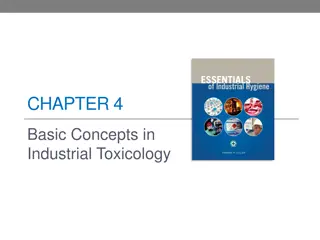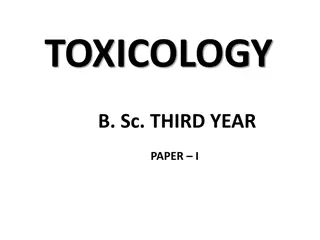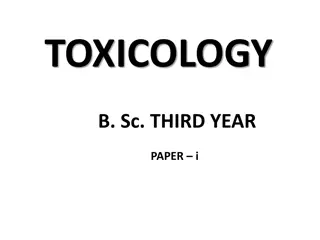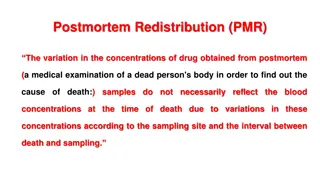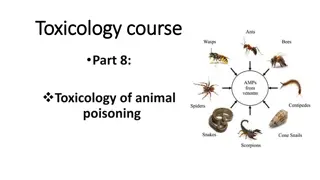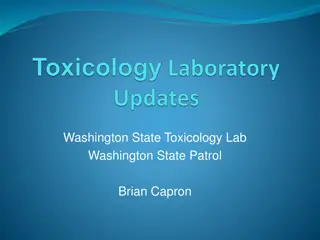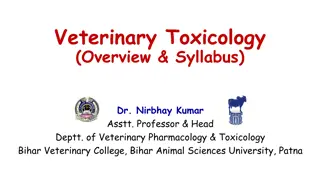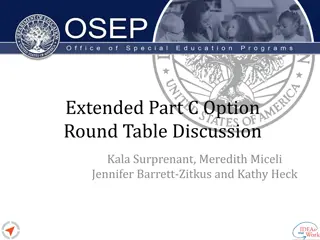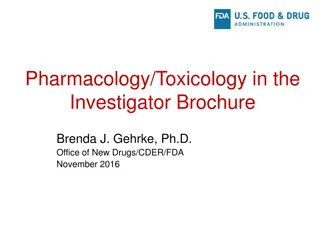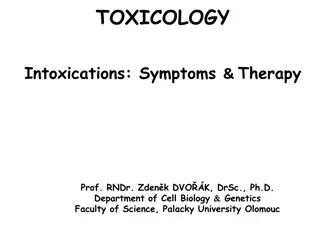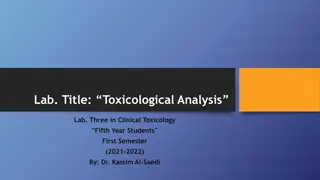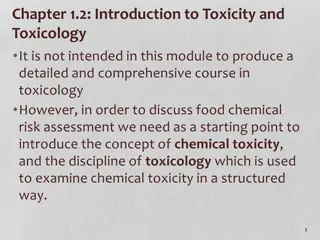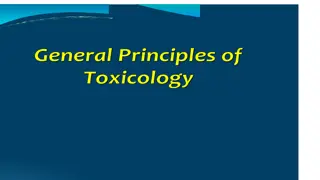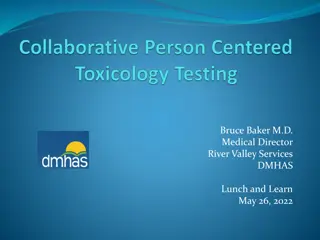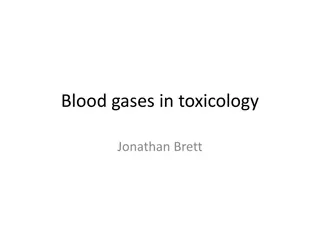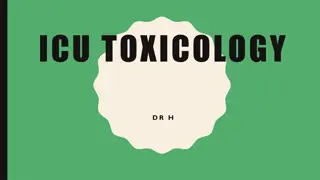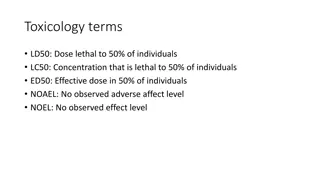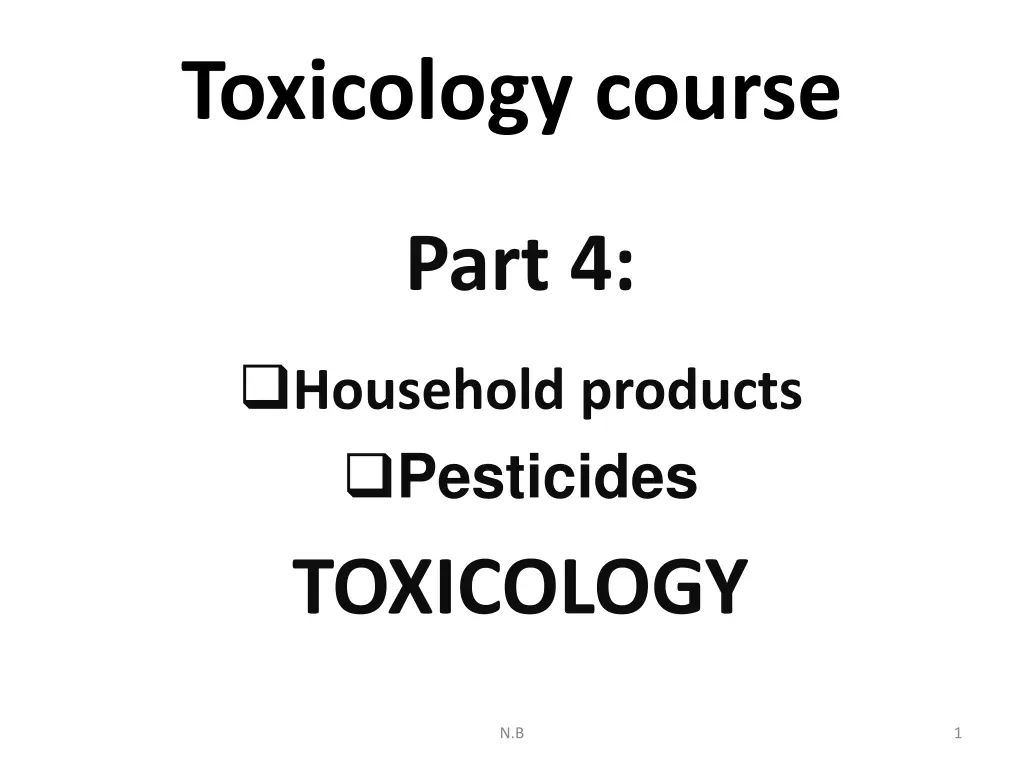
Household Products Toxicology: Understanding the Risks and Safety Measures
Explore the potential dangers posed by common household products and pesticides, the leading causes of poisoning, and the toxicity levels indicated on product warning labels. Learn about harmful substances in cleaners, soaps, detergents, rust removers, and batteries, and how they can affect human health and the environment.
Download Presentation

Please find below an Image/Link to download the presentation.
The content on the website is provided AS IS for your information and personal use only. It may not be sold, licensed, or shared on other websites without obtaining consent from the author. If you encounter any issues during the download, it is possible that the publisher has removed the file from their server.
You are allowed to download the files provided on this website for personal or commercial use, subject to the condition that they are used lawfully. All files are the property of their respective owners.
The content on the website is provided AS IS for your information and personal use only. It may not be sold, licensed, or shared on other websites without obtaining consent from the author.
E N D
Presentation Transcript
Toxicology course Part 4: Household products Pesticides TOXICOLOGY N.B 1
Household products N.B 2
Any chemical / mixture that may be harmful to the environment and to human health if inhaled swallowed or absorbed through skin. These toxic substance contained in everyday household products. Poisoning due to household substances is usually mild. N.B 3
Drugs and household cleaners are the most reported cases of poisoning. Easy availability of household product makes them one of the leading causes of poisoning. Usually target age: under the age of five, majority were children between the age of 1-3 years. N.B 4
Product warning label indicates level of toxicity No label = LD50 > 5 g/kg Caution = 0.5 5 g/kg Warning = 50 500 mg/kg Danger: Poison = <50 mg/kg N.B 5
Commonly used harmful household products Cleaners: Used to remove dirt mostly contains fragrance, surfactants & pesticides. Surfactants remove dirt & pesticides kill germ like bacteria and viruses. Glass cleaners Ammonia, Isopropanol Dish washers Cationic, anionic or nonionic detergents Oven cleaners Lye (Na/K hydroxide) All purpose cleaners Ethylene glycol, Na hyperchlorite N.B 6
Soaps, Shampoos, Detergents: Most have low toxicity, Usually cause only vomiting and diarrhea Cationic surfactants are found in contact lens solutions, fabric softeners: can cause neuromuscular and ganglionic blockade as well as GI ulcerations, acidosis and shock Anionic surfactants are in many cleaning products like shampoos have the potential to cause hemolysis N.B 7
Rust removers: Mold and rust are kind of funguses. Pesticide chemicals found in these products are chlorine, alkyl ammonium chloride. Very caustic and corrosive. Batteries: Dry cell Carbon + Heavy metal Wet cell used for vehicles, lead and battery acid(H2SO4) N.B 8
Button & Disk Batteries: Button/Disk battery single cell batteries used as an energy source for digital watches, calculators, cameras etc. Contains heavy metals and potassium oxide solution. If swallowed majority no symptoms passed intact with feces. If impacted in esophagus fever, dysphasia, vomiting and anorexia Tissue damage cause by flow of electric current, potentially fatal. N.B 9
Bleaches/ Disinfectants: Used to kill germs Depending on the specific product usually do not cause serious harm if a small amount is swallowed. Average amount may cause serious poisoning and even death. Germicide chemical-acids, alkalis, pine oil, phenol..... N.B 10
Paints/ Polishes Paints: Water base - mostly used for indoors. Main solvent is water Oil base mineral spirit and other petroleum distillate. Used for out doors. Polishes: Furniture polishes & metal cleaners petroleum distillate. N.B 11
Treating Household Cleaner Ingestions If a potentially toxic amount of a non- corrosive compound ingested, emesis should be induced; no activated charcoal unless systemic effects are expected For corrosive compounds: 1) dilute with milk or water 2) determine exactly how much of what material was ingested N.B 12
Treating Toxic Corrosive Ingestions If there is pain, dysphagia, excessive drooling, or ulceration and the exposure was potentially toxic: Establish airway and get esophagoscopy If esophagus can t be examined quickly, start corticosteroids Symptomatic and supportive care N.B 13
Petroleum Products Gasoline, mineral spirits, kerosene, lighter fluid, nail polish remover, solvents, motor oil, furniture polish, Break fluid, car coolant, antifreezer. Biggest worry is aspiration causing hydrocarbon pneumonia Pneumonia risk related to viscosity; less viscous = more toxic. Break fluid, car coolant, antifreezer ethylene glycol, highly toxic damage to heart, kidney & brain can cause death. N.B 14
Systemic Toxicity of Hydrocarbons Most hydrocarbons are CNS depressants Some volatile hydrocarbons sensitize the heart to catecholamines and can cause sudden death due to cardiac arrest Many hydrocarbons cause dermal irritation and hair loss N.B 15
Signs of Hydrocarbon Toxicity CNS: Depression, lethargy, ataxia, seizures, coma Respiratory: Dyspnea, coughing, wheezing, X- ray changes in lungs with pneumonia Spontaneous vomiting and aspiration often occurs with more volatile compounds N.B 16
Treating Hydrocarbon Ingestions Wash for dermal exposures Do not try to increase viscosity by adding heavier compound Do not induce emesis unless a large, life threatening ingestion (>1 ml/kg) Monitor for pneumonia; treat with antibiotics if present N.B 17
Pesticides N.B 18
As any substance or mixture of substances intended for preventing, destroying, repelling, or mitigating pests. Pests can be insects, rodents, weeds, and a host of other unwanted organisms. About 800 compounds of active ingredients of pesticides have been registered world-wide. Most pesticides are not highly selective, but are generally toxic to many non target species N.B 19
there are a sufficient number of nonfatal poisonings from general pesticide use, averaging about 5000 cases annually in the United States. The four major classes: 1. Insecticides (insects) 2. Herbicides (weeds) 3. Fungicides (fungi, molds) 4. Rodenticides (rodents) Texas center N.B 20
Groups of pesticides include: - Organochlorine pesticides - Organophosphates - Carbamate pesticides - Pyrethroids - Phenoxyacetic acid based pesticides - Urea based pesticides - Diazine and triazine pesticides - Bipyridil based pesticides - Phenylpyrazoles - Metal based pesticides With each class, there is several subclasses exist: Ex: insecticides organochlorines .. DDT N.B 21
Exposure to pesticides: Exposure to pesticides can occur via the oral or dermal routes or by inhalation. Oral route: High doses: leading to severe poisoning and death (suicidal intents, or of accidental ingestion) Chronic low doses: are consumed by the general population as pesticide residues in food, or as contaminants in drinking water N.B 22
The dermal route: is believed to offer the greatest potential for exposure for Workers involved in the production, transport, mixing and loading, and application of pesticides, as well as in harvesting of pesticide- sprayed crops, or in case of accidental spillings. Slow penetration through the tissue and/ or to potential exposure of others, if clothes are not changed and washed on termination of exposure Respiratory route: when aerosols or aerial sprayings are used. N.B 23
Pesticide degradation the most important factors are light, temperature, photolysis, free radicals produced in photochemical reactions, hydrolysis. 2. phase XH X OH The final products are inactive and are excreted. 1. phase X O conjugate N.B 24
Acute Toxicity pesticides Dermal: skin irritation, reddening, itching Oral: nausea, muscle twitching, sweating, weakness Inhalation: burning of throat and lungs, coughing Eye: temporary or permanent irritation or blindness N.B 25
Chronic toxicity of pesticides Cancer birth defects infertility or sterility Impotence blood disorders (anemia, inability to clot) brain damage Paralysis emphysema, asthma kidney problems N.B 26
REMEMBER: Low-level exposure to chemicals that have potential to cause long- term effects may not cause immediate injury, but repeated exposures can greatly increase the risk of chronic adverse effects. N.B 27
INSECTICIDES Are neurotoxicants, and act by poisoning the nervous systems of the target organisms Insecticides play a most relevant role in the control of insect pests, particularly in developing countries. The organophosphates, are involved in a great number of human poisonings and deaths each year N.B 28
N.B 29
Insecticides and antiparasitics Have high acute toxicity, with oral LD 50 values in rat often below 50 mg/kg. Mechanism of toxicity: 1. inhibition of Acetylcholine esterase enzyme causes accumulation of acetylcholine at cholinergic synapses, with over stimulation of cholinergic receptors of the muscarinic and nicotinic type N.B 31
N.B 32
Respiratory failure is a hallm of severe OP poisoning The agents are The agents are most rapidly absorbed after most rapidly absorbed after inhalation inhalation allmark N.B 33
2. The Intermediate Syndrome: The syndrome develops one to several days after the poisoning, during recovery from cholinergic manifestations. weakness of respiratory, neck, and proximal limb muscles. Mortality due to respiratory paralysis and complications ranges from 15% to 40%, and recovery in surviving patients usually takes up to 30 days There is no specific treatment N.B 34
3. Organophosphate-Induced Delayed Polyneuropathy: Tingling of the hands and feet, followed by sensory loss, progressive muscle weakness and flaccidity of the distal skeletal muscles of the lower and upper extremities, and ataxia. These may occur two to three weeks after a single exposure. N.B 35
Management of organophosphate poisoning 1. check airway, breathing, circulation 2. monitor arterial oxygen saturation, cardiac rhythms, BP, Pulse rate. 3. look for signs & symptoms. 4. obtain IV access. N.B 36
Treatment of Poisoning: Dermal : contaminated clothing should be removed, and the skin washed with alkaline soap. rinsing the eyes Oral: procedures to reduce absorption from the gastrointestinal tract do not appear to be very effective .. give activated charcoal (50 g in 200 ml) N.B 37
Atropine: it is a muscarinic receptor antagonist, and thus prevents the action of accumulating acetylcholine on these receptors. Doses of atropine in adults are 1 or 2 to 5 mg in case of mild or moderate poison. 1.8-3.0 mg fast iv bolus-after 3-5minutes check the five parameters of cholinergic poisoning: N.B 38
1. Poor air entry into the lungs due to bronchospasm 2. excessive sweating 3. bradycardia ( <60 ) 4. hypotension 5. Miosis If above parameters are not corrected, double the dose of atropine every 5 minutes until at least 3/5 of below parameters corrected: 1. clear chest with no wheeze 2. heart rate 80-100 bpm 3. systolic BP > 90 mmhg 4. pupils no longer pinpoint Higher doses by continuous infusion may be required in severe cases Atropinization should be maintained for at least 48 hours N.B 39
Oximes, such as pralidoxime (2-PAM), are also used in the therapy of OP poisoning. Mechanism of action: 2-PAM contains a positively charged atom capable of attaching to the anionic site of AChE, and facilitates dephosphorylation of the enzyme. Dosing regimens for various oximes depend on the specific compound and the severity of OP poisoning (30mg/kg loading dose Iv over 10- 20mins followed by continuous infusion of 8- 10mg/kg/hr until clinical recovery) Inadequate dosing is major factor for lack of response to oxime therapy and aging of ACh N.B 40
Diazepam (10 20 mg) is also used in the treatment of acute OP poisoning to: relieve anxiety in mild cases to reduce muscle fasciculations antagonize convulsions in the more severe cases N.B 41
Management of complications 1.Respiratory failure: ET intubation and mechanical ventilation required if - tidal volume <5mm/kg - vital capacity < 15 ml/kg -apnoic spells are present -PaO2 < 08 Kpa& FiO2 > 60% 2.Pulmonary oedema: furosemide 40-80 mg iv 3.convulsion: 5-10 mg iv diazepam 4. ventricular tachycardia: temporary pacing 5. bronchopneumonia: antibiotics & chest physiotherapy N.B 42
2. Carbamates N.B 43
Insecticides, herbicides, and fungicides Ex: Carbofuran: Birds Exposure: oral and dermal (lower) Mechanism of action: inhibit AChE inhibition is transient and rapidly reversible, since there is rapid reactivation of the carbamylated enzyme in the presence of water. Signs and symptoms: include miosis, urination, diarrhea, salivation, muscle fasciculation, and CNS effects (poor penetration of the blood-brain barrier limits CNS toxicity of carbamates) The treatment: symptoms relive, the use of the muscarinic antagonist atropine. N.B 44
3. Pyrethroids N.B 45
Pyrethroids are used widely as insecticides both in the house and in agriculture in medicine for the topical treatment of scabies and head lice, and in tropical countries for malaria control, both in soaked bed nets to prevent mosquito bites and in indoor residual spraying. Values of LD 50 are low: for example, from 100 mg/kg (deltamethrin) to 10,000 mg/kg (phenothrin). N.B 46
Insecticides and antiparasitics Toxic for fish and bees Mechanism of the toxic action - - pyrethroids T (tremor) contain no -cyano group cause reversible block of sodium channels (e.g. permethrin) - pyrethroids CS (choreoatetosis, salivation) contain -cyano group cause reversible block of sodium channels and inhibition of GABA (e.g. deltamethrin) N.B 47
N.B 48
Signs and Symptoms: N.B 49
4. Organochlorine Compounds (DTT) in agriculture, structure insect control, and malaria Their acute toxicity is moderate (less than that of organophosphates), but chronic exposure may be associated with A.E particularly in the liver and the reproductive system..fat soluble Have been banned in most countries in the past 30 years. Yet, because of their environmental persistence and high lipophilicity, exposure to these compounds continues, most notably through the diet N.B 50


